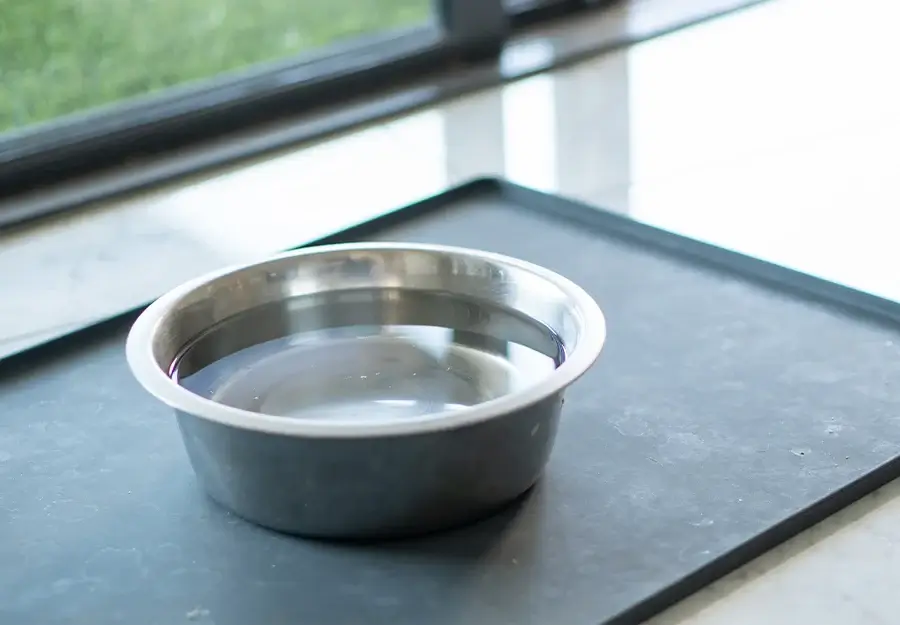
How Long Can Dogs Go Without Water? When you're out and about with your dog, or if your dog is waiting not-so-patiently at home for you, it's important to make sure they are properly hydrated. Find out just how long can a dog go without water.
Learn about how much water dogs need each day, how long your dog can safely go without water, why your pup won’t drink water, signs she may be struggling with dehydration, and what you can do to keep her healthy and hydrated all summer.
Keeping your pet hydrated is vital to his health, just as it is to your own. He should always have a fresh, clean supply of drinking water available to him. But what happens when your dog isn’t drinking enough water?
Can dogs get dehydrated, as humans do? How long can a dog go without water? And why won’t your dog drink water, even when it’s offered to her?
Read on to learn tips about how much water your dog should drink and how to tell if your dog is dehydrated.
Why is Water Important for Dogs?
Water is one of the most underrated nutrients for dogs. Unlike food ingredients that offer energy, vitamins and other compounds to support your dog's health, water is often overlooked because its nutrition is more of a facilitating support than a functional one.
This means that water itself doesn't supply any nutrients, but it is vital in how nutrients are digested, absorbed, moved, and excreted through your dog's body. Here are a few processes of your dog's body that need water to function properly.
Digestion
Water is involved in all parts of digestion. Water in your dog's body helps produce saliva, stomach acids, and bile, and plays a role in every stage of digestion. Without moisture, your dog's body would be unable to break down food into individual nutrients.
Furthermore, water assists in moving nutrients into and through the bloodstream to be properly distributed to each system in the body.
Cell Cycle
Water is one of the core components of a cell. Without sufficient water in your dog's body, the cell cycle will be hindered, especially cell growth and division. The initial results of this will present as poor skin and coat health.
Detox
Water in your dog's system helps to flush out toxins from the bloodstream and during digestion. Harmful toxins and excess water-soluble nutrients will be filtered out through the kidneys and excreted in urine by the water in your dog's body.
Dehydration is likely going to contribute to the build-up of harmful compounds in your dog's body, but it can lead to kidney and urinary tract issues if the organs can not be properly flushed.
Temperature
Dogs typically don't mind warm weather, but summer's extreme heat and humidity can lead to a dog quickly overheating. Proper hydration is vital to your dog's natural ability to maintain their body temperature.
Dogs sweat through their paws and pant to release heat, both rely on appropriate water levels in the body. Other precautions should be taken to keep your dog cool and comfortable in hot weather, such as the right dog cooling gear, but proper hydration is an important part of the solution.
How Much Water Should Dogs Drink?
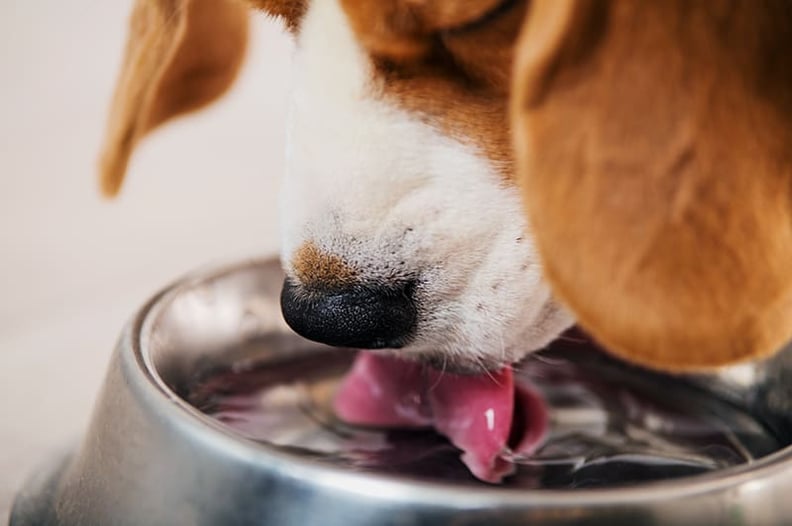
Water makes up more than 70% of your dog’s body by weight, so your dog needs to maintain this water content by consuming plenty of water every day. We know the recommendation for us is eight 8-ounce glasses of water a day, but what about your dog?
A good guideline for dogs is about an ounce of water for every pound of body weight. So, a 25 lbs. dog needs about 25 oz. of water (or 3 cups), while a 75 lbs. dog needs almost 2 litres of water every day.
This may seem like a lot, but remember, this is spread out across their whole day, and, as we will learn later, there are plenty of other ways to supplement your dog’s hydration needs than simply offering him a cold, refreshing small amount of water.
Help! My puppy not drinking enough water!
If it seems like your puppy is not drinking enough water, keep in mind that puppies have a different need for water than adult dogs.
As they are being weaned and transitioning to solid food, puppies need to drink around half a cup of water every other hour to replace the milk they’re not getting and keep themselves hydrated.
Once your puppy is weaned, she will begin to need more water than before, ultimately requiring as much water as a fully-grown doggo.
Puppies also learn by repetition, so even though they may not go to the water bowl on their own as often as they should, you should keep bringing them back to the bowl frequently throughout the day to build the habit of drinking water more regularly.
This will, of course, affect their bathroom needs, so if you are potty training your puppy or dog training, this will mean that consistent bathroom breaks will be needed.
Warning Signs That Your Dog is Dehydrated
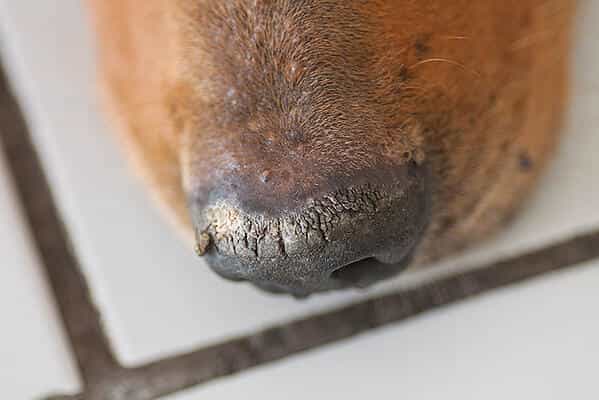
How can you be sure that your dog is getting enough water? It’s impossible to measure out and keep track of how much water your dog drinks every minute of the day.
Cases of extreme dehydration in dogs are typically associated with illness or overheating, but a consistent state of mild dehydration can have risks too. It’s helpful to be able to identify signs of dehydration in dogs so that you can take action.
If you’re worried that your dog may be dehydrated, here are a few areas to check:
Dry Nose
Your dog’s nose is naturally moist. A dry nose doesn’t necessarily mean dehydration, but it can be an indicator when combined with other signs. A dog's nose that is dry, cracked, or flaky could indicate that he's dehydrated.
Other reasons for a dry nose could include allergies, air quality, or irritation. In addition to keeping your pooch properly hydrated, try a topical treatment to moisten and condition the nose, like Parker & Co. Snout Balm.
Dry, Tacky Gums and Pasty Saliva
Another naturally moist area of your dog is his gums. Lift your dog’s lips and touch your finger to his gums to see if they are dry or tacky. If so, then he needs a drink soon.
It's common for gums and noses to be dry after a nap. A dry mouth is not uncommon during rest cycles, especially if your dog sleeps with his mouth open. Don't panic if your dog is looking a little parched just after waking up from a puppy dream. Just encourage him to head to the water dish for a quick drink.
Another indication is the viscosity of your dog’s saliva. If your dog isn’t drinking enough water, his saliva will become thick and pasty as a response.
Low Skin Elasticity
Have you ever lifted the skin on your finger joints to check for dehydration? The elasticity of your dog’s skin is the best way to determine moderate dehydration. Grab a handful of skin from their back and gently lift. Release the skin and take note of how long it takes to fall back into place. If the skin lingers in position, like a little skin mohawk, then your dog needs a drink pretty badly.
Remember that this test is not as effective for breeds with a lot of extra skin. Doing this test on a Sharpe, Bulldog, or another really wrinkly breed will likely give you a false positive
Dark Yellow Pee, or Very Little Pee
The colour of your dog’s pee can indicate dehydration too. Light yellow and pale urine is typically a good sign of proper hydration. The darker the yellow, the less hydrated your dog is.
This can also be indicative of other health concerns, though, so if your dog’s urine colour is unaffected by better hydration, then it’s time to call the vet to rule out other issues.
Low Energy Level and/or Lethargy
If your doggo is dehydrated, he won’t have the energy to be as playful as he typically would be. Just like you, the lack of fresh water will sap him of energy and leave him feeling weak and tired, interested primarily in snoozing and being generally lazy.
Loss of Appetite
Have you ever tried to swallow a dry piece of toast without any coffee, fresh water, milk, or juice to wash it down? It was likely not only very difficult but also uncomfortable and even painful.
Dehydration can make swallowing food too painful for your doggo, spurring him to avoid eating altogether. Your dog’s digestive system requires water to process the food he has eaten, which would also make him disinterested in eating.
Sunken, Dry Eyes
Your dog’s eyes are made primarily of water, as are the muscles behind her eyes. When she is dehydrated, these muscles and the eyes themselves are too dry to rotate properly, causing them to look sunken.
Also, when your doggo hasn’t been drinking enough water, the delicate skin of her eyelids is not moisturized, so they cannot naturally clean her eyes, making them dry and irritated.
How Long Can Dogs Go Without Water?
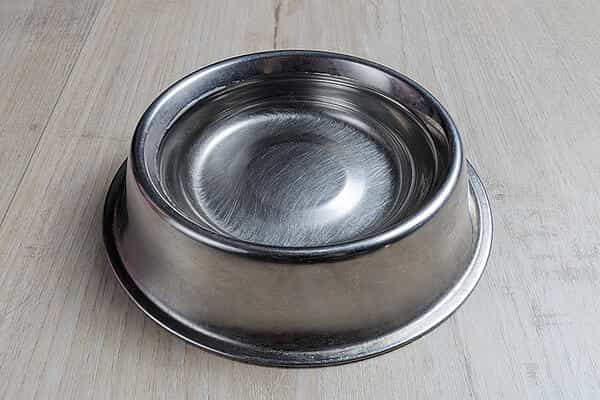
How long can a dog go without water? Your doggo is a beloved member of your family, and just like the rest of your family, your dog needs plenty of water every day. But we’ve all been in a mad rush to work and ran out the door without refilling our dog’s water bowl.
Sometimes, too, due to illness, lifestyle changes, or general anxiety, your dog may simply be uninterested in drinking water. Let’s talk about how long your dog can safely go without water.
When it comes to determining how long your doggo can go without water, there is no one-size-fits-all answer. Here are a few factors to consider:
Age
Your adult dog needs much more water per day than, say, a puppy does, so your puppy can do without water for much longer than your adult dog. Your elderly canine companion likely has health issues that would be further exacerbated by prolonged dehydration.
Health
If your canine companion has health issues, it’s important to make sure they drink water every day, as dehydration in dogs affects every organ in the body, intensifying any illness. Also, it goes without saying that a pregnant dog will need to drink plenty of water every day.
Weather Conditions
If you live in a mild climate, your dog will be fine without water for longer than that same dog living in a hot, dry, or humid environment. Remember: heat means more panting, which means more water loss.
Breed
Breeds with big thick coats, more active breeds, and breeds that drool a lot may need more daily water intake to combat normal water loss. The more water your dog loses through daily activities and habits, the more water will need to be replenished.
Overall Lifestyle
If your dog is a lazy house pup (we love them!), she may be able to endure a longer time period than a more active dog would. Generally speaking, the more active your dog is, the more water he will need and the worse off he will be without water for long periods of time.
Under normal circumstances, a dog can go 6-10 hours without water without any ill effects. If you forget to top up his water bowl before leaving for work, or if your dog knocks his bowl over while you’re gone, don’t panic. He will be fine if he is indoors, cool, and in good health.
The general rule of thumb is that your dog can survive approximately 72 hours without water, but after the first 24 the effects of dehydration will start to present. Beyond that, you could be causing irreparable damage. We need to be as serious about keeping our pups healthy as we are about keeping ourselves and our families healthy.
Though some have suggested withholding water to stop dogs from urinating in the house or in their crate all day when their owner is at work, it is important to never intentionally leave your dog without water for any reason.
What Happens to a Dehydrated Dog?
You know why proper hydration is important, but unfortunate circumstances may prevent your dog from having access to water, or your dog may choose not to drink due to illness. Take a look at what a dog would experience each day as he becomes more and more dehydrated.
Day 1
After a full day without water, your dog may have less energy than usual. As he starts to feel more and more dehydrated, you may also notice him panting heavier. This is how your dog cools down.
Offer fresh, cool water and moisture-rich food frequently and in small doses. This will help how to rehydrate a dog and help to cool his body gradually.
Day 2
Two full days without water will lead to more severe symptoms of dehydration in dogs. You will likely notice some weaknesses and behavioural issues. Mobility may be limited due to lethargy, so it’s best to keep your dog in a limited, calm, and quiet area of the house while you rehydrate him.
Bring water and moisture-rich foods to him to encourage him to drink. You can use a clean, soaked washcloth to dab water onto his gums. This may also encourage him to drink a little.
Day 3
By the third day, your dog is in critical condition with no water or moisture-rich food. To safely rehydrate your dog, he will need IV fluids. In this crucial stage, your dog will be very lethargic and weak. He will likely not be able to walk very far or at all.
Immediate intervention is needed to prevent organ damage and even death. If your dog is flat and unable to drink, you need to get him to a vet ASAP. If your dog experiences vomiting or diarrhea during this time, he is seriously dehydrated and will need immediate medical attention.
Why Won't My Dog Drink Water?
Help, my dog won't drink water! If your dog shows signs of dehydration and refuses to drink fresh, clean water, it's important to find the cause.
Healthy dogs are generally pretty good at regulating their water intake. When they are thirsty, they instinctively seek out water. But why won’t my dog won’t drink water, you may be wondering.
It’s possible that an underlying issue is at play. It could be as simple as an upset tummy or as serious as an intestinal or urinary blockage. How to get a dog to drink water?
Another common reason your dog won’t drink water is because of some injury to his mouth. If his mouth, tongue, gums, or teeth are sore, he may not be interested in either eating or drinking.
If you notice that your dog is not drinking or eating, then you need to take action, particularly if your dog has been vomiting or has experienced consistent diarrhea.
This is especially dangerous because he quickly loses moisture on top of not consuming enough water or food to replenish that loss.
Choose the Right Bowl
It may seem silly that something as simple as the shape, size, or material of your dog's water bowl may deter them from drinking, but it can! Some dogs are pickier than others, so the style of bowl you choose may not be to their liking.
The bowl may be too deep, leaving them with no option but to dunk their face into the bowl, or the bowl may be flat and wide, causing them to dip their ears in the water every time they take a sip.
Material can be a factor too. Plastic bowls easily scratch and crack, allowing odour-causing bacteria to build up. Try switching to a metal or ceramic to keep the water cleaner and more refreshing.
Here are a few options you can try:
Lastly, if you find your dog has no qualms about dunking his head in the toilet, but won't drink from his water bowl, then you are better off investing in a good quality dog water fountain.
This will keep the water moving, dropping the temperature by a degree or two. While this may not seem like much, it might be just enough to make the water more appetizing for your doggo.
Other Ways to Keep Your Doggo Hydrated
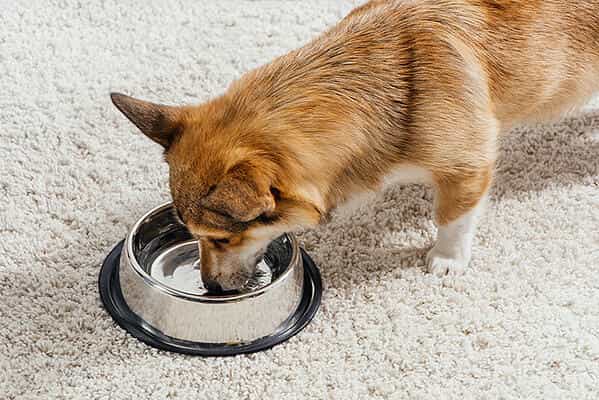
Keeping your pet hydrated isn’t always as simple as leaving out fresh, clean water. If your dog doesn’t drink enough water on his own, for one reason or another, consider other ways to get moisture into his body.
Moisture-Rich Dog Food
If your dog won’t or can’t drink the recommended amount of water, then you should try to get your dog to eat moisture-rich foods to prevent dehydration. Canned, juicy dog food is a great way to hydrate your dog while keeping his diet complete and balanced.
Canned foods can be fed with kibble diets or as a meal in themselves. Check out some of our favourite wet foods for dogs:
If you don’t want to make significant dietary changes, then consider a food topper or treat that can offer extra moisture to your dog. Fresh fruits and veggies are an excellent source of essential nutrients and are also loaded with moisture. Just make sure you choose produce that is safe for dogs.
Check out our other fun and delicious dog treat recipes to help keep your dog hydrated and his taste buds happy.
Tasty Water Alternatives
Another way to get your dog to drink more is to offer beverages that have a little more flavour. Try pouring raw goat’s milk into his food or making some dog popsicles out of bone broth. These tasty snacks are refreshing and full of moisture—and they’re great ways to sneakily keep your dog hydrated.
For a hot day, or when your doggo will be spending more time outside, consider offering her frozen treats, like the long-lasting puzzle treat, stuffed Kong.
Keep in mind that these doggy drinks should never wholly replace fresh, clean water. Feeding these liquids with meals is best so you don’t discourage your dog’s regular drinking habits.
Your canine companion needs water, just like you do. A dehydrated doggo is not only likely to be down in the dumps, but he is also at risk for serious illness and even death. With these tips and tricks, you can be ahead in ensuring your dog is hydrated, happy, and healthy.
Frequently Asked Questions
How long can a healthy adult dog typically go without water?
A healthy adult dog can usually go without water for about 6 to 10 hours without any negative effects.
Are there any factors that can influence how long a dog can go without water?
Yes, things like age, size, activity level, and even weather conditions can affect a dog's water needs.
What are the signs that a dog may be getting dehydrated?
Signs of dehydration in dogs include dry gums, sunken eyes, lethargy, and dark yellow urine.
Can puppies go longer without water than adult dogs?
No, puppies have higher water requirements and should not go as long without water as adult dogs.
Is it safe to leave water out for my dog all day?
Yes, it's safe to leave fresh water available for your dog throughout the day, but remember to change the water daily and sanitize the bowl weekly to prevent bacteria build-up in the water.
How can I encourage my dog to drink more water, especially in hot weather
You can encourage your dog to drink more water by keeping their bowl clean, offering ice cubes, and feeding tasty dog-safe frozen snacks.

.png?width=200&height=66&name=logo%20(1).png)




.jpg)
